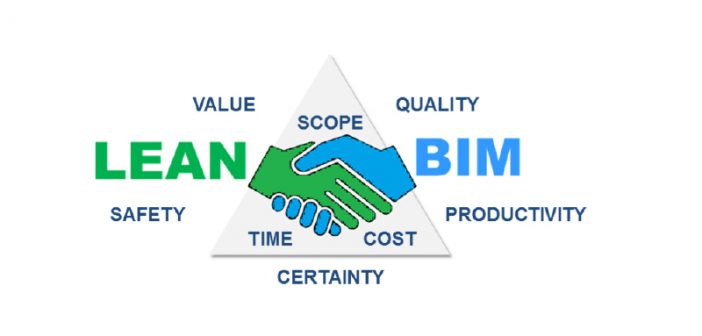The Lean Construction Institute, Community of Practice (CoP) Ireland, hosted a webinar entitled “BIM for Lean Construction”. This was presented by Ralph Montague, Managing Partner of ArcDox, a leading BIM consultancy practice based in Dublin. Ralph no outlines the relationship between BIM and Lean Construction.
Ralph explained Lean Construction and its relationship to BIM, “The objectives of Lean Construction, is to continually improve processes, productivity and eliminate waste in construction, to realize more value for both clients and the supply chain (i.e. not to deliver more value at the expense of others, but by converting waste back to more quality and value).”
“Of course, the planning, design, construction and operations of buildings, is highly dependent on having good quality ‘information’, at the right time, in a useful/usable format, in order to make decisions or carry out some element of work. The quality of information profoundly affects the performance and outcomes. It is the ‘information’ that creates the relationship between BIM and Lean Construction because BIM is all about ‘how’ we produce, manage, exchange information about the building (or built infrastructure), using modern technologies (and virtual building models).”
Ralph told us how BIM can help reduce waste, “Traditionally ‘information’ was provided in paper-based documents (like reports, drawings, schedules, specifications, etc). Even though people may be using digital technologies like CAD or Excel, the end deliverable is still a paper document. These documents are all manually produced, have to be manually coordinated and checked, and usually contain many human errors, leading to confusion, misunderstanding, delays, cost-overruns, disputes or litigation. The traditional methodology for producing, managing and exchanging information, is outdated, time-consuming, labour-intensive, costly and wasteful, and as such, is not in keeping with the principles of Lean Construction.”

[rev_slider dronewide]
“You can see that the BIM methodology, of focusing the intellectual and productive input, into the construction of the virtual building, where the information is only created once, in the models, and if needed to be changed, only updated once in the models, is a far more efficient way of producing, managing, and exchanging ‘information’ across the project team, providing far more opportunities for better collaboration. Therefore, BIM fits very neatly into the Lean Construction principles of improving the process and reducing waste, to achieve higher value for everyone.”
[rev_slider bimawardside]Identifying the need for client and stakeholder involvement and an industry standard for BIM, Ralph said, “The benefits of BIM are not going to be realized or achieved, unless there is a clearly defined process put in place that requires each participant on a project, to produce, manage and exchange information in this way. Clients need to know how to ask for BIM in the correct way, and the supply chain need to know how to deliver BIM in the correct way. We need an industry standard. And fortunately for us in Ireland, we don’t have to invent that standard. In the UK, they developed the PAS1192 specification for information management, to support the government mandate, and they have made this freely available. We just have to start using this. PAS1192 is currently becoming an International and European standard (IS019650 under ISO-TC59 & CEN-TC442), and builds on other existing international standards for ‘open BIM’.”
“I don’t believe that the objectives of Lean Construction can be fully realized without the use of BIM.”




